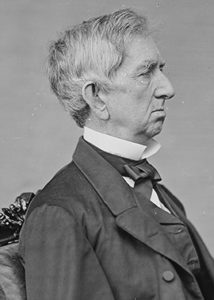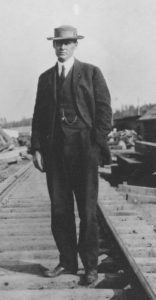November 1, 2014
Building the Alaska Railroad 1914-1923
Alaska, our 49th state, was once owned by Russia. In 1867, needing money and worried that the British might seize Alaska for Canadian territory, Russia offered to sell its distant colony to the U.S. The American government was equally concerned that the British not expand Canada. Secretary of State William H. Seward negotiated a treaty in which the United States handed over $7.2 million ($119 million today) in gold bullion to the Imperial Russian Government, in exchange for a vast wilderness, twice the size of Texas, that bordered the Arctic Circle.

The newspapers of the day called it “Seward’s Folly,” and “Seward’s Icebox,” and questioned the value of acquiring this remote and forbidding land of deep forests, wild rivers, and towering mountain ranges. It was located so far north that for weeks in winter the sun barely rose, and for weeks in summer the sun barely set. Except for scattered settlements of native Aleut and Tlingit peoples, the interior of Alaska was unexplored and inaccessible. Untold mineral wealth might lie beneath its permanently frozen subsoil, but in 1867 there was no practical way to get at it, or bring it out.
Alaska remained undeveloped until 1897, when the discovery of gold in the neighboring Canadian Yukon awakened U.S. interest in its faraway territory. Government geological expeditions were sent deep into the backcountry; they reported finding large reserves of coal, copper and other minerals. By the early 1900s mining companies had begun exploiting these resources. Several shortline railroads were constructed to carry the coal and copper ore out. There were no rail connections through British Columbia, so the loads had to be dumped into barges at the port towns of Cordova and Seward and then towed 1200 nautical miles south to the nearest U.S. port at Seattle. The shortlines soon found that operating in a sub-Arctic climate with essentially one way traffic devoured their profits. With a population in 1910 of less than 65,000 people, Alaska could not support a railroad run by private enterprise. If Alaska was ever to be developed, the Federal government would have to build a railroad and subsidize its losses.
In Seattle, business interests saw such a possibility as a tremendous opportunity for their city. They lobbied Congress hard to enact a railway bill. The U. S. Navy was also interested in getting Alaska coal for their North Pacific squadron. In December 1913, President Woodrow Wilson included a proposal for an Alaska rail line in his State of the Union message, and declared: “We must use the resources of the country, not lock them up.”

On March 12, 1914, the Alaska Railroad Bill was enacted into law. Congress appointed an engineering commission to oversee the project, and gave it a simple mandate: build a rail line not to exceed 1,000 miles long that would connect Alaska’s Pacific coast with its interior coal fields, and do it for $35 million ($842 million today).
Frederick Mears, a career Army officer and civil engineer was put in charge of surveying and construction, at a salary of $10,000 per year. Mears had served in the infantry during the Phillipine Insurrection in the early 1900s in the aftermath of the Spanish American War. In 1906 he went to work on the Panama Canal, in charge of relocating the Panama railroad and operating it. In 1914 the canal opened and Mears was available for an even greater challenge.
The building of the Alaska Railroad was an engineering achievement comparable to the Panama Canal. Mears commanded an army of civilian workers and contractors, which at the peak of construction numbered 4500. Except for what could be utilized of the existing shortline railroads, everything needed for a major railroad had to be created from scratch: rail yards and depots, machine and repair shops, housing for workers, hospitals, power plants, and sawmills for converting tree trunks into cross-ties. Town sites, streets and waterworks were laid out for the increase in population which the railroad would bring. Engineers, surveyors, track gang bosses, doctors and nurses, cooks and telegraphers, had to be hired; many of them were veterans of the Panama Canal construction.
Modern docks had to be built at Seward, on the south coast and at Ship Creek, a small village at the head of Cook Inlet on the Pacific side, which would soon be re-named Anchorage. Into these new harbors would come shiploads of rail, spikes, tie plates and switch stands; reels of telegraph and telephone wire; timber and steel bridge sections, steam shovels, derricks, locomotives, freight and passenger cars. With few roads into the outback, trucks were of little use. Thousands of horses were needed to haul equipment and supplies; each animal, kicking and whinnying, was lowered to the dock by a canvas sling under its belly.
Copyright © 2014, Aldon Company, Inc.
References
- “Uncle Sam’s Experiment: TRAINS goes to Alaska,” TRAINS Magazine, April and May, 1963.
- “Railroads Across North America, An Illustrated History,” Claude Wiatrowski.
- “Portrait of the Alaska Railroad,” Kaylene Johnson.
- “Rails Across the Tundra, An Historical Album of the Alaska Railroad,” Stan Cohen.
- Wikipedia: “Alaska Railroad,” “Alaska Purchased,” “History of Alaska,” “Mears Memorial Bridge”
- “The Alaska Railroad,” THE ENGINEERING AND MINING JOURNAL, Nov. 7, 1914
- Alaska Railroad Travel, www.alaskarailroad.com.
- “Get Mears!, Frederick Mears, Builder of the Alaska Railroad,” Katherine Carson Crittenden.
- “Pocket List of Railroad Officials,” 4th Qtr 2014, JOC Group.
Photo Credits
- William H. Seward: Wikipedia
- Frederick Mears, a career Army officer and civil engineer: Library of Congress
